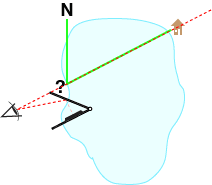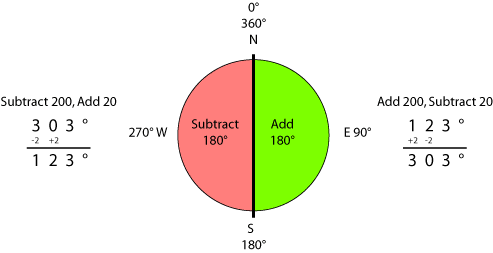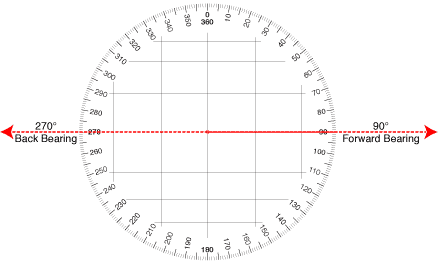Understanding forward and back bearings

The first compass bearing we need to take at the lake is from our unknown location to our cabin on the far shore. The bearing we end up with represents the angle between a line from Magnetic North to our location, and a line from our location to the cabin. This bearing is a "forward bearing."
But when we go to plot this bearing on our map, we can't plot the angle from our current location since that is what we are trying to find. Instead we plot a bearing from the cabin, as if someone there took a bearing "looking BACK towards our location." This would be called a "back bearing" and will be 180° different from our "forward bearing."
How to determine a back bearing
One technique is to do the math. Add or subtract 180° from you forward bearing to get your back bearing. You want the result to fall between 0° and 360°, so if the forward bearing is less than 180°, add 180° to it, and if it's greater than 180°, subtract 180°.

If you are bad with math in your head, the "200/20" trick might help you. When your bearing is less than 180°, add 200° and then subtract 20° (same as adding 180°). When your bearing is greater than 180°, subtract 200° and then add 20° (same as subtracting 180°).

There are also lots of tricks that avoid doing the arithmetic entirely...
Most sighting compasses show the back bearing in a smaller font size above or below the forward bearing.
When you are taking a bearing with a base plate compass, and you want a back bearing instead of a forward bearing, box the compass needle with the south end where the north end would usually be. The resulting bearing will be 180° different.

When you are plotting your bearing, start by plotting a short segment of the forward bearing. When you extend the line, extend it in the opposite direction.

Next get straight in your head, where you will be plotting the bearing from on the map, and whether you will be plotting a forward bearing or a back bearing. You will always be starting to plot your bearing from the known location and then extending your line towards the unknown location.
If you took the bearing from the known location, you will be plotting a forward bearing, starting at the known location.
If you took the bearing from the unknown location, you will be plotting a back bearing, starting at the known location.